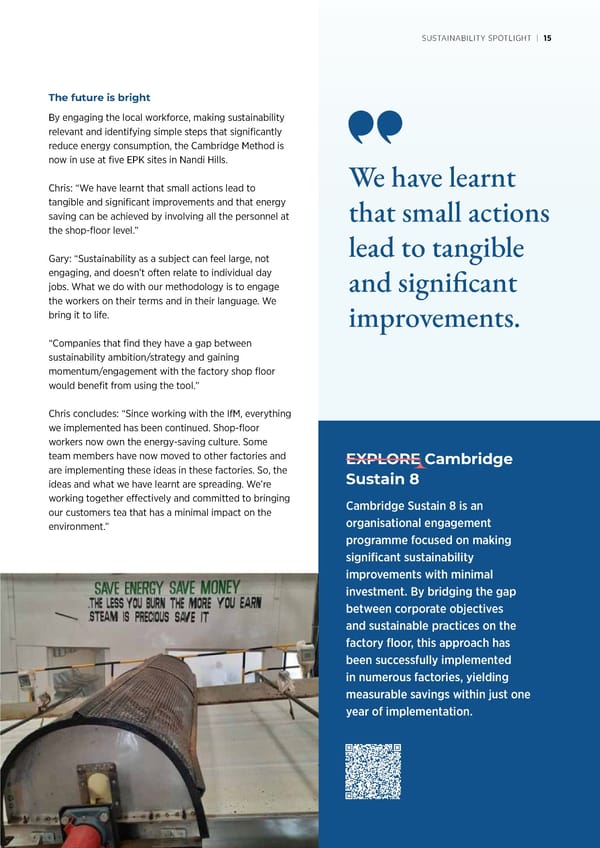SUSTAINABILITY SPOTLIGHT | 14 SUSTAINABILITY SPOTLIGHT | 15 After 12 months, teams reported a 15%–30% reduction “This wasn’t about us coming in and telling them what The future is bright in thermal and electric energy consumption at both they need to do, then leaving. EPK had already been By engaging the local workforce, making sustainability sites. There was also a significant increase in tea engaging in various energy-saving activities. This was relevant and identifying simple steps that significantly produced per unit of fuel wood (kWh/m3).about walking alongside them, listening to them, and reduce energy consumption, the Cambridge Method is getting them involved.now in use at five EPK sites in Nandi Hills. “Now, there is the controlled start-up of machines after a power outage,” says Chris Ballard, Technical Director “For example, we encouraged the leadership team to Chris: “We have learnt that small actions lead to We have learnt of EPK. “No machines are left idle or running when not establish their targets, to establish local improvement tangible and significant improvements and that energy in use. There is also proper work output by employees teams to undertake surveys and implement their action saving can be achieved by involving all the personnel at that small actions who now understand that their work has a direct impact plans and provide recognition for all the hard work the shop-floor level.” on energy savings. The shop-floor teams appreciate the involved.” load-shedding regime and no longer see it as a limiting Gary: “Sustainability as a subject can feel large, not lead to tangible factor in withering operations.For Fred Oberi, a drier operator at Kepchomo Factory, engaging, and doesn’t often relate to individual day the changes have resulted in professional growth: “I was jobs. What we do with our methodology is to engage “We have also adopted a new way of covering firewood motivated to get involved since I was made to realise and signiocant in the yard, resulting in high firewood utilisation that my role as a drier operator was critical in sustaining the workers on their terms and in their language. We e ciency compared to previous years. Data on the company’s business as opposed to how I have bring it to life.improvements. electrical energy use is collected from each section of been perceiving it. In addition, the awareness of energy “Companies that find they have a gap between the factory. The data is compared between all factories, saving has improved my ability to avoid wastage of sustainability ambition/strategy and gaining highlighting ine cient sections of a factory that must important resources at work and on a personal level.”momentum/engagement with the factory shop floor be improved.would benefit from using the tool.” Chris Ballard echoes the crucial role that the IfM “These actions have led to significant energy savings at played in engaging the sta : “Everything was in place Chris concludes: “Since working with the IfM, everything both sites, and there has been an overall improvement mechanically, but the next step was to get the people we implemented has been continued. Shop-floor in factory performance across all areas,” says Chris.involved. Crucial to this was engaging the shop-floor workers now own the energy-saving culture. Some workers in the energy-saving plan. This worked because team members have now moved to other factories and How many cows have we saved?they are the ones who understand the operations EXPLORE Cambridge of every machine, since they are the users, and they are implementing these ideas in these factories. So, the Sustain 8 Gary explains that one of the key success stories has ideas and what we have learnt are spreading. We’re been getting the local team engaged in the changes understand the challenges and areas for improvement. working together e ectively and committed to bringing and making the sustainability gains relevant to their They are the ones who know possible areas for our customers tea that has a minimal impact on the Cambridge Sustain 8 is an context. “We engaged the factory workers on their improvement, and therefore they had to own the environment.”organisational engagement terms and in their language. We did this by converting process first. programme focused on making energy into something recognisable: not gigajoules, but significant sustainability ‘How many cows can you buy with the savings?’ This “The shop-floor teams took the project as their own and gave us all a laugh but e ectively equated to how much not a ‘Cambridge University’ project. Engaging the sta improvements with minimal energy had been saved. It brought understanding to the created ownership of the process and how the process investment. By bridging the gap room – that energy wasn’t something intangible. By the directly impacted their personal lives,” says Chris.between corporate objectives end of the project, they worked out that they had saved and sustainable practices on the 2,000 cows – the size of the president’s herd!”“We’ve been working on factory e ciency for many years,” Chris continues. “So, it’s not just something factory floor, this approach has Gary recognises that local e orts have been mirrored that’s happened. The IfM clarified precisely what we been successfully implemented by a strong commitment from EPK HQ to try something should be doing, focusing on, and getting the factory in numerous factories, yielding new, as well as supportive managerial and technical personnel involved. measurable savings within just one leadership on the ground in Kenya: “The open and year of implementation. positive culture of the Kenyan factory management “We knew where all the problems were, but it’s getting and factory sta , coupled with our empathy and intentions turned into action, which is challenging, and understanding of ‘real’ factory challenges and simple that is where the IfM helped.” methodology, meant we could see impactful changes almost immediately.
 Sustainability Spotlight Magazine Page 14 Page 16
Sustainability Spotlight Magazine Page 14 Page 16